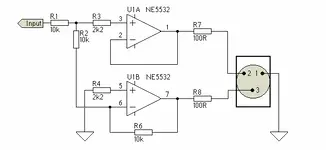C
chipwits
New member
Kevin (or anyone else that knows),
I notice many amplifiers also have balanced inputs. My question is, is it really needed?
Microphones to preamps definitely need balanced since it is a very low voltage , low impediance signal traveling potentially over many feet. I understand the purpose here. However, the output of my D/A converter to Volume Attenuator to amplifier is only about 3 or 4 feet. Also the signal is at line level by this time, and much higher impedance.
Would I hear any difference whatsoever if I only ran 2 feet of unbalanced cable from my Volume Attenuator to my amp? I also wonder what many of the amplifiers *really* do inside with the balanced signal, if they do the correct differential amplification etc with it, or just really only uses the non-inverterted signal of the two.
The reason I ask this is, I want to save on cost of parts in my DIY volume attenuator. For balanced, I'd need twice as many resistors and relays.
James
I notice many amplifiers also have balanced inputs. My question is, is it really needed?
Microphones to preamps definitely need balanced since it is a very low voltage , low impediance signal traveling potentially over many feet. I understand the purpose here. However, the output of my D/A converter to Volume Attenuator to amplifier is only about 3 or 4 feet. Also the signal is at line level by this time, and much higher impedance.
Would I hear any difference whatsoever if I only ran 2 feet of unbalanced cable from my Volume Attenuator to my amp? I also wonder what many of the amplifiers *really* do inside with the balanced signal, if they do the correct differential amplification etc with it, or just really only uses the non-inverterted signal of the two.
The reason I ask this is, I want to save on cost of parts in my DIY volume attenuator. For balanced, I'd need twice as many resistors and relays.
James

 i just need to either get the headphone socket fixed, or else hook up something that will allow me to switch the audio coming from my computer to go between the denon amp or a separate headphone amp. anyway, don't want to monopolise this thread - got my own going now...
i just need to either get the headphone socket fixed, or else hook up something that will allow me to switch the audio coming from my computer to go between the denon amp or a separate headphone amp. anyway, don't want to monopolise this thread - got my own going now...
